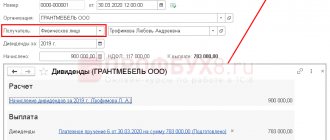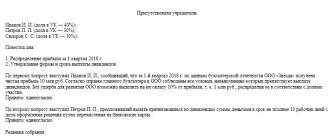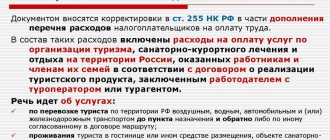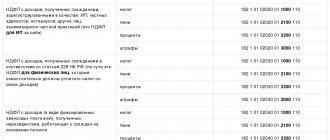In this article we will look at how to calculate dividends in 1C 8.3 Accounting 3.0. Let's assume that our organization is a limited liability company with several founders. Each of the owners has a certain block of shares. There can be any number of share owners. Even ordinary employees of an enterprise have several shares. They will also receive dividends.
The recipient of dividends can be either an individual or a legal entity. Dividends can also be received by owners of joint-stock companies, closed joint-stock companies, open joint-stock companies, etc. In essence, this is an investment of your own funds at interest. Only, unlike a regular bank deposit, the amount of profit received from investments is not fixed, but depends on the company’s profit.
In our example, we will consider step by step not only the calculation of dividends in 1C Accounting 8.3, but also the calculation of personal income tax, since this type of income of individuals is subject to it.
A little about the legislative framework
Dividends are a portion of profits that owners can distribute to themselves as a reward for profitable operation based on the performance of their enterprise. At the same time, it is important to understand that the presence of money in the current account is not an indicator of the profitability of the activity; accordingly, this is not enough to transfer dividends.
According to paragraph 1 of Art. 28 No. 14-FZ, as well as clause 1 of Art. 42 the company has the right to distribute profits once a quarter, half a year or once a year. The entire process of distributing funds must be prescribed in the company's charter so that each distribution procedure is legal and justified. If the profit has not been distributed among the owners, it is recorded in the retained earnings account.
According to the financial statements, net profit is determined, which is the source of funds for paying income to the founders.
At the same time, it is completely unclear where to look, if not at the balance in the current account. But often the opposite situation arises: there is profit, but there is no money in the current account to make payments for the distribution of profit. Therefore, later we will look at how to determine the amount of dividends in the program.
The amount of dividends is subject to personal income tax, as well as to any type of income of an individual, if the founder of the company is an individual, and income tax, if an organization. In this case, the payer organization will be a tax agent for personal income tax for income recipients, in simple words - you will pay the tax amount to the budget on part of the profit paid, and transfer the rest to the founders. You must pay the tax on the day or the next business day you receive income (take into account weekends and holidays). These are all the tax obligations that you will have when distributing your company's profits.
The general meeting of founders (or shareholders) makes a decision on the payment of dividends; its decision based on the results of the meeting must be formalized in the minutes of the meeting. It specifies the amount and timing of payments, dates and form of payments, as well as a list of founders and shareholders who are entitled to a portion of the company’s profits.
There are cases when a company does not have the right to distribute the income of an enterprise among the founders, these include:
— not all participants contributed their shares to the authorized capital in full and on time;
— at the time of distribution of dividends, the organization is in a state of bankruptcy, or will be in bankruptcy after payment;
- if it turns out that the value of net assets is lower than the authorized capital of the enterprise (we will show their calculation below in the article);
- before the repurchase of shares of the joint-stock company, which are subject to repurchase in accordance with the law, etc.
The procedure for distributing net profit in relation to legal entities does not have any distinctive features and is subject to the general procedure prescribed in legislative acts. There is a peculiarity with the taxes paid. For legal entities, a profit tax is also established, which is paid by the tax agent when transferring income to the founders-legal entities on the day of transfer or on the next business day. Income tax is 13%, and is reflected in the tax return of the quarter in which the income was paid.
So, let's summarize. What to do when a company plans to distribute its profits:
— We determine the amount of profit on the date specified in the charter (based on the results of the quarter, half a year, year);
— We hold a meeting of participants, draw up a protocol with the recommended amount of dividends, the timing and method of payment, as well as a list of income recipients;
— We calculate them in the program, pay them, and transfer the tax to the budget.
— Don’t forget to include all amounts accrued to the owners in the 6-NDFL and 2-NDFL certificate, as well as in the income tax return for legal entity founders.
Automation of accrual and payment of dividends in 1C: Accounting 8 edition 3.0
Starting with release 3.0.60 in the 1C: Accounting 8 edition 3.0 program, the process of accrual and payment of dividends to individuals and legal entities is automated. A new document, Accrual of Dividends, has appeared. The documents Payment order and Write-off from the current account now have a new type of operation: Transfer of dividends, and the document Cash Withdrawal has a similar type of operation: Payment of dividends. The changes also affected the Chart of Accounts. A new subaccount 68.34 “Income tax when performing the duties of a tax agent” has been added to account 68. As analytics for accounts 75, 80 and 81, a new type of subaccount “Founders” is used, the value type of which is two directories: Individuals and Counterparties.
In this article, we will use a specific example to see how it is now easy to calculate and pay dividends in the 1C: Accounting 8 edition 3.0 program, and at the same time we will check the correctness of the operations we perform.
A dividend is any income received by a shareholder (participant) from an organization when distributing the profit remaining after taxation on shares (shares) owned by the shareholder (participant) in proportion to the shares of shareholders (participants) in the authorized (share) capital of this organization (clause 1 of Art. 43 of the Tax Code of the Russian Federation (TC RF)).
The company has the right to make a decision quarterly, once every six months or once a year on the distribution of its net profit among the company's participants. The decision is made by the general meeting of the company's participants. Profit is distributed in proportion to the shares of participants in the authorized capital of the company, unless a different procedure is established by the charter of the company. The term and procedure for payment of distributed profit are determined by the company's charter or a decision of the general meeting of company participants.
Let's look at an example. Limited Liability Company "Rassvet" applies the general taxation regime - the accrual method. The net profit based on the organization’s operating results for 2021, subject to distribution among the founders, is 4,000,000 rubles. The company has two founders: an individual - a tax resident of the Russian Federation and a legal entity - a Russian organization. The share of each founder's contribution to the authorized capital of the company is 50%. The balance sheet for accounts 80 and 84 of the Rassvet organization is presented in Fig. 1.
Picture 1.
According to the decision of the general meeting of participants, the amount of income due to each of the founders is 2,000,000 rubles. Payment of the specified income, in accordance with the charter of the company, was made on March 26, 2021 to the bank accounts of the founders.
The debt to the LLC participants for the payment of dividends is reflected in the accounting records as of the date of the decision made by the general meeting of the company participants on the distribution of net profit.
In accounting, the direction of profit of the reporting year for the payment of income to participants is reflected in the debit of account 84.01 “Profit to be distributed” in correspondence with the credit of account 75.02 “Calculations for payment of income”.
In accordance with paragraph 3 of Art. 275 of the Tax Code of the Russian Federation, a Russian organization that is a source of income for the taxpayer in the form of dividends is recognized as a tax agent. The organization determines the amount of tax separately for each taxpayer, in relation to each payment of the specified income.
The amount of tax subject to withholding from the income of the taxpayer - recipient of dividends is calculated by the tax agent according to the formula given in paragraph 5 of Art. 275 Tax Code of the Russian Federation:
N=K*Sn*(D1*D2)
,
where N is the amount of tax to be withheld;
K – the ratio of the amount of dividends subject to distribution in favor of the taxpayer - recipient of the dividends to the total amount of dividends subject to distribution by the organization; Сн – tax rate established by paragraph. 1 or 2 p. 3 tbsp. 284 or paragraph 1 of Art. 224 NK; D1 – total amount of dividends to be distributed; D2 – the amount of dividends received by the tax agent himself. In accordance with paragraph 1 of Art. 224 of the Tax Code of the Russian Federation, the tax rate for income received in the form of dividends by individuals who are tax residents of the Russian Federation is set at 13%.
In accordance with paragraphs. 1 and paragraphs. 2 p. 3 art. 284 of the Tax Code of the Russian Federation, the tax rate for income received in the form of dividends by Russian organizations can be set at 0% or 13%. In our example, a rate of 13% is applied.
The organization itself did not receive dividends, since it does not take part in the activities of other organizations.
Consequently, the amount of tax to be withheld from the founders’ income is 260,000 rubles (0.5 * 13% * 4,000,000 rubles).
In accordance with paragraph 4 of Art. 226 of the Tax Code of the Russian Federation, tax agents are required to withhold the accrued amount of tax directly from taxpayers’ income upon their actual payment.
To calculate dividends in the program, we will use the new document Accrual of dividends. Let's start with the founder - an individual.
The document is very simple. It is necessary to indicate the type of recipient - Individual and select the founder. Select the period for which dividends are calculated and indicate the accrued amount. Let's take a close look at the results of this document.
The document, as expected, accrued dividends in accounting on the debit of account 84.01 in correspondence with the credit of account 75.02. The amount of personal income tax calculated from the income of the founder - an individual is reflected in the debit of account 75.02 in correspondence with the credit of account 68.01 “Income tax for individuals”.
In addition, the document generated entries in two accumulation registers: - in the register Calculations of taxpayers with the budget for personal income tax for the amount of calculated (receipt) personal income tax with the type of income Dividends and code 1010; — to the Income Accounting register for calculating personal income tax on the amount of income received by an individual. An example of the document Accrual of dividends for an individual and the result of its implementation are presented in Fig. 2.
Figure 2.
Now all we have to do is transfer the amount of dividends, minus personal income tax, to the bank account of the founder - an individual. The Payment Order document can be created on the basis of the Dividend Accrual document or in a completely automated way using the “Pay” button (the button automatically generates the entire set of documents necessary for the payment of dividends). The document uses a new type of transaction: Transfer of dividends. The generated Payment order document is shown in Fig. 3.
Figure 3.
When you receive a bank statement about the transfer of funds to the recipient’s account, you need to create in the program (download from the client bank) a document Write-off from the current account with the transaction type Transfer of dividends. In the document, in order to automatically reflect in the personal income tax accounting subsystem the fact of tax withholding and the correct generation of reports 2-NDFL and 6-NDFL, it is necessary to indicate the basis document (Accrual of Dividends document).
When posted, the document in accounting will generate a posting on the debit of account 75.02 in correspondence with the credit of account 51 “Current accounts”. In addition, the document will generate entries in the personal income tax registers. Since, in accordance with paragraphs. 1 clause 1 art. 223 of the Tax Code of the Russian Federation, when receiving income (including dividends) in cash, the date of actual receipt of income is determined as the day the income is paid, including the transfer of income to the taxpayer’s bank accounts, the document in the Income Accounting register for calculating personal income tax will “correct” the date receiving income. Reverses the old entry created by the Dividend Accrual document and creates a new one with a new date for receiving income (although in our example, the date of accrual of dividends coincides with the date of their payment).
In the register Calculations of taxpayers with the budget for personal income tax, the date of receipt of income will also first be adjusted (the actual date of receipt of income is needed to generate the 6-NDFL report), and then an entry will be made for the amount of personal income tax withheld (expense). Since personal income tax is withheld, it must be transferred to the state budget. Therefore, an entry will be made in the register for the amount of personal income tax withheld. Calculations of tax agents with the personal income tax budget are the amount of tax that an organization must pay as a tax agent for a specific individual. The document Write-off from the current account and the result of its execution are presented in Fig. 4.
Figure 4.
No later than the day following the payment of income, in accordance with clause 6 of Art. 226 of the Tax Code of the Russian Federation, it is necessary to transfer the withheld personal income tax to the budget. The Payment Order document can be created based on the Dividend Accrual document or using the “Pay” button. Transaction type used Tax payment. The Payment Order document is shown in Fig. 5.
Figure 5.
When you receive a bank statement about the transfer of withheld personal income tax to the budget, you need to create in the program (download from the client bank) a document Write-off from the current account with the transaction type Tax payment. Tax - personal income tax when performing the duties of a tax agent.
When posting the document in accounting, it will generate a posting for the debit of account 68.01 in correspondence with the credit of account 51 and make the necessary entries in the personal income tax registers. The register Payment of personal income tax by tax agents (for distribution) will reflect the fact of payment of the amount of personal income tax to the budget (Receipt), but this amount may apply to several taxpayers (individuals). Therefore, the amount of tax paid is distributed among individuals (Expense) in proportion to the withheld personal income tax. In this case, we pay tax only for one individual.
In the register Calculations of tax agents with the budget for personal income tax, the fact of transfer of personal income tax for a specific individual (Expense) - the recipient of dividends will be reflected. Based on this register, personal income tax reports for individuals reflect the transfer of tax. The document and the result of its implementation are shown in Fig. 6.
Figure 6.
To check the correctness of our actions in the program, we will create a Tax Accounting Register for personal income tax (located in the Salary Reports section) for our founder.
In March, the taxpayer received income - dividends (income code 1010) in the amount of 2,000,000 rubles. The tax calculated was 260,000 rubles. The tax was withheld on 03/26/2018, the transfer deadline is 03/27/2018. The tax has been transferred and payment order details are available. That's right! A fragment of the Tax Accounting Register for personal income tax is shown in Fig. 7.
Figure 7.
To be completely sure, we will generate a 6-NDFL report. The date of actual receipt of income, the date of tax withholding and the transfer period are correct. The amount of income actually received is 2,000,000 rubles, the amount of tax withheld is 260,000 rubles. A fragment of the regulated 6-NDFL report is presented in Fig. 8.
Figure 8.
Now let's move on to the second founder - the Russian organization. To calculate dividends, of course, we will also use the document Accrual of dividends. We will indicate the type of recipient - Legal entity and select the counterparty - the founder. Select the period for which dividends are calculated and indicate the accrued amount.
The document will automatically calculate the amount of withheld tax at a rate of 13% (clause 2, clause 3, article 284 of the Tax Code of the Russian Federation). But please note that the tax amount is editable. This is done so that, if necessary, if a tax rate of 0% is used (clause 1, clause 3, article 284 of the Tax Code of the Russian Federation), the accountant can set the tax amount to zero rubles.
When carried out, the document will accrue dividends in accounting on the debit of account 84.01 in correspondence with the credit of account 75.02. The amount of tax calculated from the income of the founder - a legal entity, is reflected in the debit of account 75.02 in correspondence with the credit of account 68.34 “Income tax when performing the duties of a tax agent.” An example of the document Accrual of dividends for a legal entity and the result of its implementation are presented in Fig. 9.
Figure 9.
The Payment order document for transferring the amount of dividends can be created based on the Dividend Accrual document or using the “Pay” button. The document uses the transaction type Transfer of dividends. The Payment Order document is shown in Fig. 10.
Figure 10.
Upon receipt of a bank statement, it is necessary to create (download from the client bank) a document Write-off from a current account with the transaction type Transfer of dividends. In the document, in order to automatically fill out the income tax return, you should indicate the basis document (Accrual of Dividends document).
When posted, the document in accounting will generate a posting for the debit of account 75.02 in correspondence with the credit of account 51. The document Write-off from the current account and the result of its posting are presented in Fig. eleven.
Figure 11.
The Payment Order document for paying corporate income tax on income received in the form of dividends can be created based on the Dividend Accrual document or using the “Pay” button. The document uses the transaction type Tax payment, tax - Income tax on dividends.
The tax must be transferred to the budget no later than the day following the payment of income. The Payment Order document is shown in Fig. 12.
Figure 12.
When receiving a bank statement, you need to create in the program (download from the client bank) a document Write-off from a current account with the transaction type Tax payment. Tax - Income tax on dividends.
When posted, the document in accounting will generate a posting for the debit of account 68.34 in correspondence with the credit of account 51. The document Write-off from the current account and the result of its posting are presented in Fig. 13.
Figure 13.
The income tax on dividends calculated by the taxpayer as a tax agent is reflected in Section 1.3 of the Income Tax Return. Type of payment (code) - 1 for income in the form of dividends (income from equity participation in other organizations created on the territory of the Russian Federation). The amount of tax to be paid is 260,000 rubles. The payment deadline is March 27, 2018. Everything is absolutely correct! Section 1.3 of the income tax return of the organization “Rassvet” for the first quarter of 2021 is presented in Fig. 14.
Figure 14.
As we have seen, the operations of accrual and payment of dividends to individuals and legal entities in the 1C: Accounting 8 edition 3.0 program are automated correctly and convenient for users of the program.
How to calculate dividends
First, you need to understand whether at the end of the quarter the organization can distribute the profit received among the owners. First you need to make sure that the company has a profit. The most convenient way is to create a balance sheet for the period of issuing dividends and look at the amount of net profit on line 2400 of the “Income Statement”.
To do this, go to the “Reports” section - “Regulated reports” - Create. We are looking for an accounting reporting form, setting a period, say January-June. A report form opens, fill it out.
Having made sure that the company has a profit, you need to make sure that the net assets of the enterprise exceed the value of its authorized capital. The procedure for calculating net assets was approved by Order of the Ministry of Finance dated August 28, 2014 No. 84n.
| Indicator name | Balance line code | For the 1st half of the year |
| Assets | ||
| Assets (Sections I and II) | 1600 | 26 258 |
| — | ||
| Short-term liabilities | 1400 | 2 000 |
| — | ||
| long term duties | 1500 | 18 711 |
| + | ||
| revenue of the future periods | 1530 | 0 |
| — | ||
| Debt of participants on contributions to the authorized capital | 1170 | 0 |
| Total net assets | 5547 thousand rubles. | |
The authorized capital of the enterprise is indicated on line 1310 of Section III of the balance sheet.
You can also see its value in the balance sheet for account 80.
Net assets are well above the minimum threshold, so the company's profits can be distributed without harming its financial condition.
The credit of account 84.01 shows the company's profit.
This shows the amount of net profit that the owners of the enterprise can distribute among themselves.
The owner of this company is one individual. The program did not have a separate operation for the formation of the authorized capital, so participants were entered through manual transactions, as well as the accrual of dividends. Now there are specially designated operations for this.
To accrue dividends to it, go to the “Operations” section - Accrual of dividends.
In the list that opens in the top panel, wait for “Create”.
You need to enter the date, the recipient, who is selected from the drop-down list using the down arrow, the period for receiving dividends and their amount for each recipient. Note that in this case the amount of tax is calculated on the amount of money paid and the amount payable is shown. Let's go through the document and look at the postings.
In debit 84.01 of the account, the amount of dividends in the amount of 250,000 rubles was written off. They were accrued on credit 75.02, and personal income tax in the amount of 32,500 rubles was also accrued on credit account 68.01.
Now let’s return to the document and click the “Pay” button in the upper right part.
Two payment orders will be created based on the calculation: for the payment of dividends and for the transfer of personal income tax to the tax office.
Everything discussed above related to the situation when the owner is an individual; now let’s imagine that the participants of the company are legal entities.
We also follow the link “Accrual of dividends” in the “Operations” section and create a new document.
This time we will select a legal entity as the recipient and select the founder we need from the list of counterparties. We indicate the period for which dividends are accrued and enter the amount. The amount of tax to be transferred to the budget and the amount of income to be paid excluding tax will also be calculated. Let's review the document and move on to postings.
The amount of income paid is also reflected in the credit of account 75.02, and is written off from account 84.01, i.e. Retained earnings will decrease by the amount of the dividend; this will also be reflected in the balance sheet. But the personal income tax subaccount has changed, the tax was calculated on account 68.34.
Calculating dividends
It is possible to calculate the availability of funds for the payment of dividends only after checking the points indicated in Art. 43 208-FZ of December 26, 1995, art. 29 14-FZ dated 02/08/1998. We will look at the main ones that are most often encountered in practice:
- first and most importantly: at the time of making the decision to pay, the organization must have net profit (line 2400 of the Financial Results Report);
- the amount of net assets exceeds the size of the authorized capital;
- the organization has no signs of insolvency/bankruptcy. Also, it should not suffer from the payment of dividends; such a “Feast during the Plague” is clearly prohibited by the above-mentioned laws.
Typically, the meeting that decides whether there will be dividends consists of one or three participants (as modest people, we will not dwell on examples of accruals on Gazprom shares). The meeting is held from March 1 to April 30 (Article 34 14-FZ of 02/08/1998). The decision he makes is recorded in the Protocol. The decision specifies the amount and terms of payment; in the JSC – the amount of payments by type of shares (preferred and ordinary). If there is only one founder in an LLC, then, of course, he does not hold a meeting, but makes decisions individually. Next, based on the protocol or decision of the participant, an order for the payment of dividends is issued (the Protocol, Decision and Order are drawn up in free form).
Fill out the declaration
We are required to report to the regulatory authorities that the company has paid income to its founders, calculated tax on them and transferred it to the budget. As already mentioned in the first section of the article, in the reporting quarter they fill out a report on Form 6-NDFL to reflect payments to individuals, and an income tax return for legal entities.
Regulated reports are located in the “Reports” section.
Using the “Create” command, select the 6-NDFL report from the list and fill it out.
In the first section, the amount of dividends is included in line 020, like other payments on an accrual basis, and is separately included in line 025. Similar to personal income tax, which is filled out in lines 040 and 045. Withheld tax is reflected in the general order in line 070.
Let's move on to the second section.
The date of actual receipt of income and the date of deduction of income are equal to the date of accrual and payment, and the transfer period is the next business day. The amount of income received is indicated in full, taking into account personal income tax.
Then we will fill out a 2-NDFL certificate for the individual who received the income.
Now let's create an income tax return. The path to it lies there.
Fill out Sheet 03. Section A. In the header you must select the category of the tax agent, the type of dividends, indicate the period and year for which the payment is made. Next, in line 001, fill in the amount of income paid to the legal entity. It is automatically copied to line 010. And we enter the amount in line 022 as income taxed at a rate of 13%. The income of organizations that own 50% or more of the authorized capital for more than 365 days is taxed at a rate of 0%. The exercise of this right is confirmed by a notification from the tax authority.
Next, in section B of sheet A, information is filled in about the legal entities that are named in the register of participants and to whom the dividends were transferred. The type line is entered as 00, which corresponds to the primary report; it characterizes the order of the corresponding adjustments to the declaration.
The director of the organization, the date it received income and the amount of income and tax related specifically to this legal entity are indicated. It is clear that the total amounts of accrued dividends were listed above on an accrual basis; in section B they are detailed by recipient. In our example, there is only one recipient, so the amounts will be the same.
Note. If the owners include both individuals and legal entities to whom dividend payments are made, then it is necessary to fill out separate pages in the income tax return for payments to individuals in Sheet 03 of Section A, and for legal entities. If the participants include only individuals, then there is no need to fill out an income tax return. For them, only 6-NDFL and 2-NDFL certificate for the year are submitted.
We recommend reading the article: “1C Cloud - what is it? In simple words"
Working with personal income tax
A problem with generating a 1-NDFL card may arise, as in the case of a 2-NDFL card, due to the fact that this tax is withheld at the time the funds are issued. But there is no function of making a payment. Obviously, the tax is calculated by the system, but in fact it is not withheld from the amount and the employee/founder does not pay it. This leaves the taxpayer with an unexpected debt.
However, the possibility of generating a payment is actually present, only in an empty state. Is it important to correctly create a payment so as not to change adjustments and additional reports for individuals?
To do this, you need to check the box in the accounting policy section “Accept tax as withheld.” After this, personal income tax will be calculated and written off correctly. Salaries are not sent to persons who do not work in this company; accordingly, personal income tax will not be accrued on them for wages, only dividends will be accrued in 1s zup 8.3
as a counterparty, not an employee. And payrolls are processed only for employees.
We transfer dividends
After the dividends have been accrued, you can finally please the recipients with the well-deserved amount. If the amount is credited to an individual, the transfer is made to the individual’s bank card. If the transfer is made to an organization, then to its current account. In both cases, the transfer is made using a standard payment order with the approximate purpose of the payment: “Dividends for .... According to protocol No. ... dated .... Without VAT".
Payment of personal income tax is also made by a standard payment order for the payment of this tax, with an approximate purpose of payment: “Personal income tax of 13% was withheld from dividends to the founder ... for ... year and transferred to the budget in full. Without VAT".
After making payments in the document “Write-off from the current account”
We indicate the individual or legal entity, depending on who was transferred and the account 75.02.
When paying personal income tax, debiting from the current account is processed in the same way as when paying personal income tax from wages or an advance, only we take into account that if there was a transfer of personal income tax for the payment of dividends to the organization, then account 68.34 is indicated in the debiting from the current account.
In total, if we have correctly calculated, calculated and transferred everything, then our SALT for account 75 should look the same as in Figure 6, without red positions and the final balance. It would be nice, of course, with much larger amounts and with your name indicated as the recipient.







